
The Port Republic Historic District is a 100-acre (40 ha) historic district located in the city of Port Republic in Atlantic County, New Jersey. It was listed on the National Register of Historic Places on May 16, 1991, for its significance in architecture, engineering, industry, and maritime history. The district has 110 contributing buildings, including the individually listed Amanda Blake Store, and four other contributing sites.
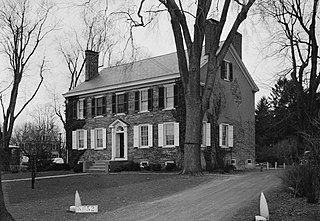
The Lawrence Township Historic District is a 550-acre (220 ha) historic district encompassing the community of Lawrenceville in Lawrence Township, Mercer County, New Jersey, United States. It was added to the National Register of Historic Places on September 14, 1972 for its significance in architecture, landscape architecture, literature, military history, and transportation. The district includes 45 contributing buildings.

The Grover Cleveland Birthplace is a historic site located at 207 Bloomfield Avenue in Caldwell, Essex County, New Jersey, United States. It is the only house museum dedicated to U.S. President Grover Cleveland.

The Reformed Dutch Church of Wyckoff is located at 580 Wyckoff Avenue in the township of Wyckoff in Bergen County, United States. The historic stone church was built in 1806 and was documented as the Wycoff Reformed Church by the Historic American Buildings Survey (HABS) in 1937. It was added to the National Register of Historic Places on April 17, 2003, for its significance in architecture. The listing includes the church cemetery.

South Park Calvary United Presbyterian Church is a historic church built in 1853 and located at 1035 Broad Street in the Lincoln Park neighborhood of Newark in Essex County, New Jersey. Only the facade remains, following a 1992 fire. Also known as the South Park Presbyterian Church, it was documented by the Historic American Buildings Survey in 1936. The church was added to the National Register of Historic Places on December 5, 1972, for its significance in architecture.

Moravian Church is a historic church building located on Swedesboro-Sharptown Road in the Oliphant's Mill section of Woolwich Township, Gloucester County, New Jersey. The church was dedicated in 1789 and documented by the Historic American Buildings Survey (HABS) in 1938. It was added to the National Register of Historic Places on April 3, 1973, for its significance in architecture and religion. The property is currently under the stewardship of the Gloucester County Historical Society.

St. Thomas Episcopal Church is a historic church located at the southeast corner of Main and Focer streets in the borough of Glassboro in Gloucester County, New Jersey. It was built in 1846 and documented by the Historic American Buildings Survey (HABS) in 1937, with an addendum in 1984. It added to the National Register of Historic Places on March 3, 1975, for its significance in architecture.

St. Luke's Episcopal Church is a historic Episcopal church building located at 346 High Street in the Hope section of Hope Township in Warren County, New Jersey, United States. Built from 1832 to 1839, it was documented by the Historic American Buildings Survey (HABS) in 1937. The stone church was added to the National Register of Historic Places on March 16, 2007, for its significance in architecture and religion. It had been previously added as a contributing property to the Hope Historic District on July 20, 1973.
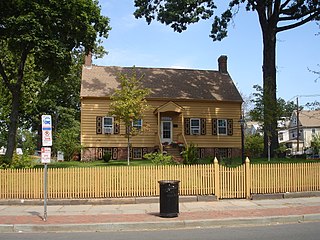
The Belcher–Ogden Mansion; Benjamin Price House; and Price–Brittan House Historic District is a 0.75-acre (3,000 m2) historic district located on East Jersey Street in Elizabeth, Union County, New Jersey, United States. It was added to the National Register of Historic Places on August 28, 1986, for its significance in architecture and exploration/settlement. It is located near Boxwood Hall and is in the heart of colonial Elizabethtown, the first English-speaking settlement in what became the Province of New Jersey.
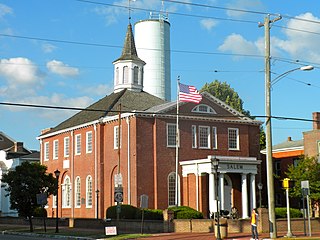
The Market Street Historic District is a 166-acre (67 ha) historic district located along Market Street in the downtown area of the city of Salem in Salem County, New Jersey, United States. It was added to the National Register of Historic Places on April 10, 1975, for its significance in architecture, art, commerce, industry, military history, religion, social history, and transportation. The district includes 44 contributing buildings.

The Miller-Kingsland House is located at 445 Vreeland Avenue in the town of Boonton in Morris County, New Jersey, United States. The house was built around 1740 and documented by the Historic American Buildings Survey (HABS) in 1938. It was added to the National Register of Historic Places on July 24, 1973, for its significance in architecture and exploration/settlement.
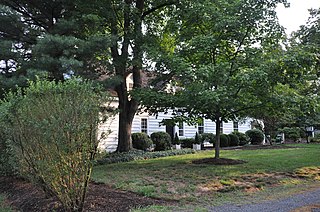
The Matthias Smock House is a historic house located at 851 River Road in the township of Piscataway in Middlesex County, New Jersey, United States. It was documented by the Historic American Buildings Survey (HABS) in 1938. The house was added to the National Register of Historic Places on December 4, 1973, for its significance in architecture. It was listed as a contributing property of the Road Up Raritan Historic District in 1997.

The Brainerd Schoolhouse is a one-room schoolhouse located at 35 Brainerd Street in Mount Holly Township, Burlington County, New Jersey, United States. Built in 1759, it is the oldest building of its type in the state and now a museum. Listed as the John Brainard School, it was documented by the Historic American Buildings Survey in 1936. Listed as the Old Schoolhouse, it was added to the National Register of Historic Places on November 26, 2008, for its significance in education. It is a contributing property to the Mount Holly Historic District. It is owned and operated by the National Society of the Colonial Dames of America.

The Oldwick Historic District is a 170-acre (69 ha) national historic district located along County Route 517, Church, King, James, Joliet and William streets in the Oldwick section of Tewksbury Township in Hunterdon County, New Jersey. The district was added to the National Register of Historic Places on November 14, 1988, for its significance in architecture, commerce, and industry. It includes 127 contributing buildings, 12 contributing structures, and one contributing site. The Kline Farmhouse, listed individually in 1984, also contributes to the district. Many of the buildings were documented by the Historic American Buildings Survey.

The Middlesex Avenue–Woodwild Park Historic District is a 89-acre (36 ha) historic district located in the borough of Metuchen in Middlesex County, New Jersey, United States. The district was added to the National Register of Historic Places on July 31, 2017, for its significance in architecture, social history, community planning and development. It includes 201 contributing buildings, five contributing objects, and one contributing site. The Borough Improvement League House, also known as the Old Franklin Schoolhouse, was documented by the Historic American Buildings Survey (HABS) in 1936, and St. Luke's Episcopal Church in 1960.

The John Smith House is a historic building located at 124 Washington Valley Road in the Washington Valley section of Morris Township in Morris County, New Jersey, United States. It was documented by the Historic American Buildings Survey (HABS) in 1937. The house was added to the National Register of Historic Places on January 1, 1976, for its significance in agriculture and architecture. It was designated a contributing property of the Washington Valley Historic District on November 12, 1992.

The Morristown District, also known as the Morristown Historic District, is a historic district in the town of Morristown in Morris County, New Jersey. It was added to the National Register of Historic Places on October 30, 1973, for its significance in architecture, communications, education, military, politics, religion, social history, and transportation.

The Davenport–Demarest House is a historic stone farmhouse located at 140 Changebridge Road in the township of Montville in Morris County, New Jersey. The oldest section was built c. 1720–1780. The farmhouse was documented by the Historic American Buildings Survey in 1938. It was added to the National Register of Historic Places on January 17, 1992, for its significance in architecture. It was listed as part of the Dutch Stone Houses in Montville Multiple Property Submission (MPS).
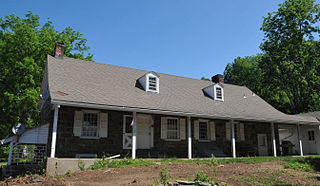
The Martin Van Duyne House is a stone farmhouse located at 292 Main Road in the township of Montville in Morris County, New Jersey. The oldest section was built around 1750. It was documented as the Abraham Van Duyne House by the Historic American Buildings Survey in 1938. It was added to the National Register of Historic Places on January 17, 1992, for its significance in architecture, and was listed as part of the Dutch Stone Houses in Montville Multiple Property Submission (MPS).

The Timothy Mills House is a historic house built c. 1740 and located at 27 Mills Street in the town of Morristown in Morris County, New Jersey. It was documented by the Historic American Buildings Survey in 1939. It was added to the National Register of Historic Places on February 24, 1975, for its significance in architecture.

























